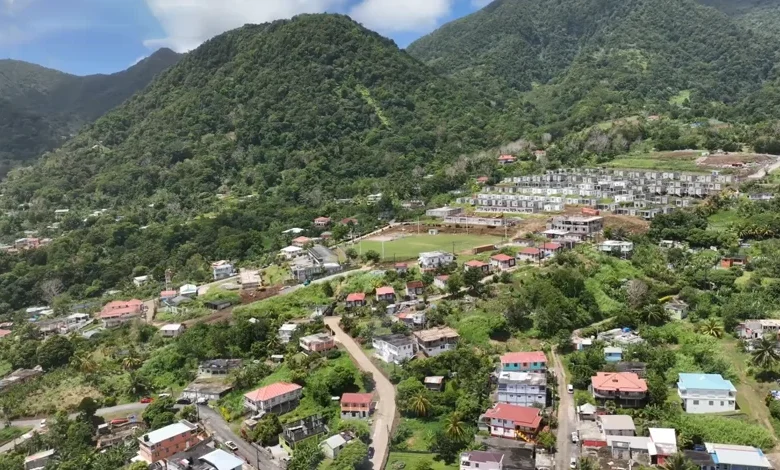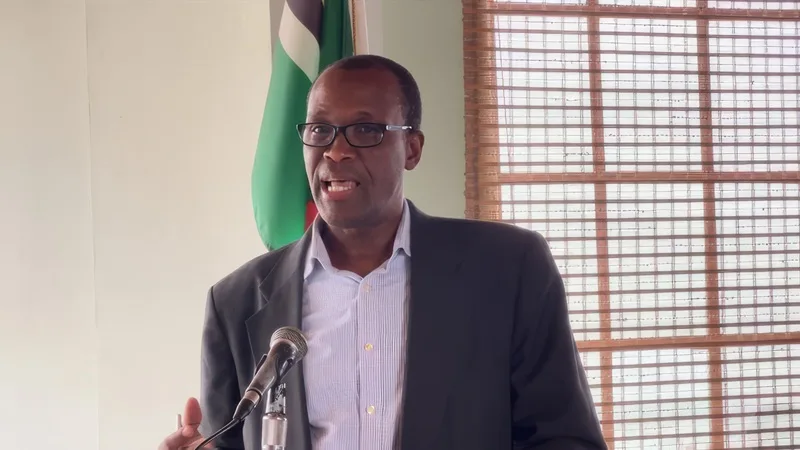Grand Bay (South City)

Grand Bay (South City), also locally known as Berekua, is the principal town of Saint Patrick Parish in southern Dominica. With a population nearing 3,000, it forms part of the Grand Bay Constituency and is the island’s cultural and political cornerstone. This coastal village, embraced by steep mountain ridges and carved by rivers and ravines, holds a unique place in Dominica’s narrative, serving as a stronghold of cultural heritage while embracing forward-thinking initiatives. From Creole language and Cadence Lypso music to political resistance and cooperative initiatives, Grand Bay has long blended pride, culture, and resilience.
Layout and Sub-Communities of Grand Bay (South City)
Grand Bay lies along Dominica’s southeast coast, facing the Atlantic Ocean. The town is nestled within a verdant valley, bordered by striking mountains such as Morne Plat Pays, Morne Anglais, and Morne Acouma. Its geographic placement positions it as a strategic crossroads between inland villages and southern coastal communities.
Sub-communities and adjacent zones that form part of Grand Bay’s social and topographic makeup include:
- Geneva – site of the Geneva Playing Field, the Grand Bay Co-operative Credit Union Ltd, and multiple businesses.
- Highland, Bolom, and Bala Park – primarily residential zones with expanding housing projects.
- Hagley, Powell, Berikua, Wavin Banan, Back Street, L’Allay, and Mabouchay – named streets and sectors forming the urban network of South City.
- Montine, Grand Coulibrie (Bordieux), Dubique, Tete Morne, Stowe, Pichelin, and Bellevue Chopin – surrounding rural settlements closely tied to Grand Bay’s economy, schooling, and culture.
The town’s street layout, showcases a growing housing sector west of Geneva, interlinked by arterial roads including the Southeast Coast Road, which enters the village via the Geneva Bridge, a key connector between Grand Bay and Dominica’s broader road network.
Historical Significance and Political Heritage
Grand Bay’s history stretches from indigenous Kalinago inhabitation to French Jesuit plantation settlements. By the 18th century, Jesuits from Martinique had established a church and agricultural holdings in the region, laying groundwork for Grand Bay’s prominence. Post-emancipation, Grand Bay became known for its radical and community-led politics, producing some of Dominica’s most progressive thinkers and political leaders.
Among them are Pierre Charles, former Prime Minister, and Nicholas Liverpool, former President, both of whom left a lasting impact on national leadership. Trade unionist Emmanuel Christopher Loblack and educator Charles S. Gregoire helped shape social reform and grassroots empowerment, while Edward Registe continued this legacy as a modern political voice for the community.
In arts and culture, reggae artist Nasio Fontaine brought international acclaim to Grand Bay, while Dr. Violet Cuffy promoted tourism and heritage abroad. Claudia Joseph has been a key figure in national cultural preservation, and Royette Tavernier represented Dominica in netball, encouraging youth in sports. Dr. Sam Christian, with roots in Grand Bay, contributed to medical services and public awareness. These ten figures reflect the area’s legacy of civic leadership, cultural pride, and global influence.
Infrastructure and Public Services
Despite its size, Grand Bay is equipped with critical infrastructure and government services. Grand Bay Health Centre serves the medical needs of the population and nearby communities, offering regular outpatient services. Law enforcement is maintained through the Grand Bay Police Station, ensuring security and public order. Educational institutions include the Grand Bay Primary School, Pierre Charles Secondary School, and early-childhood programs integrated within community outreach.
Financial needs are addressed through the Grand Bay Co-operative Credit Union Ltd, headquartered in Geneva. The town has retail outlets, bars, local groceries, and cooperative businesses. Geneva also houses the Grand Bay Community Centre, a multipurpose facility used for social functions, town meetings, and cultural workshops. The Geneva Playing Field is the main sports and festival venue and plays host to football tournaments, Creole Day celebrations, and musical concerts.
Recent housing developments, like the Grand Bay Ville Housing Project, are part of Dominica’s climate-resilient infrastructure strategy and reflect renewed focus on post-disaster recovery, especially after the devastation of Hurricane Maria in 2017.
Rivers, Ravines, and Natural Features
Geographically, Grand Bay is etched by a complex network of rivers and ravines that shape its landscape and ecosystems. The Geneva River runs adjacent to the playing field and is central to local drainage and agriculture. Ravine Chimen Chapelle, Ravine Mal Sauzay, Am Bo Saut Ravine, and Ravine Terre Elm are some of the smaller waterways and drainage channels dissecting the hilly terrain. The Ravine Morne Acouma flows between Montine and Geneva, while the Berekua Ravine forms part of Grand Bay’s northern edge.
Nature lovers and researchers are drawn to nearby trails around Morne Acouma, Terre Elm, and Bois d’Inde Ridge, which offer views of both the coast and central mountains. The surrounding peaks and gorges are also ideal for traditional herbal foraging, bush medicine practices, and freshwater bathing spots that locals have used for generations.
Culture, Language, and Festivities
Creole remains the heartbeat of Grand Bay. Spoken fluently by elders and celebrated in schools and events, the language permeates daily life. Cadence-lypso music, pioneered by Exile One and made famous across the Francophone Caribbean, is deeply rooted in Grand Bay’s culture. Village festivals often combine drum-based dances, creole poetry, bèlè performances, and craft exhibitions, particularly in the lead-up to Independence Day and Creole Heritage Month.
Cultural preservation has been driven by educators, artists, and elders who emphasize intergenerational learning. The community takes pride in maintaining traditional cooking methods, basket weaving, Creole storytelling, and sacred spaces.
Transportation, Access, and Economic Ties
Grand Bay is connected to Roseau via the Bellevue Chopin Road, which passes through Pichelin, Bellevue Chopin and Loubiere. Internal village roads such as Hagley Road, Lallay Road, and the newly paved sections in Bala Park improve neighborhood access and resilience during storms.
Minibuses form the bulk of transportation, often terminating at Geneva. Agriculture remains vital, with produce from Montine and Bordieux sold in Roseau’s market weekly. Youth also find work in construction, trades, public service, and music-related enterprises.
Ongoing Development and Community Initiatives
Community engagement in Grand Bay is active. From religious-based outreach to climate education and youth mentoring, several programs thrive. Recent initiatives include the expansion of the Geneva Community Market, post-hurricane home reconstruction, and environmental conservation near Ravine Terre Elm.
Local government representatives, past and present, have advocated for better housing, road rehabilitation, youth employment, and renewable energy. Programs tied to the Government of Dominica, along with international aid and diaspora support, continue to shape the town’s development trajectory.
Final Remarks
Grand Bay, known proudly as South City, is more than a town, it is a living symbol of Dominican resilience, pride, and progress. Its people remain deeply connected to their land, traditions, and history, while also embracing new opportunities for education, culture, and innovation. Whether through the rhythms of Asa Banton or the memory of Pierre Charles, Grand Bay continues to leave an imprint on Dominica’s national identity.




